Pocket Cop - A Body-Worn Camera Companion App
The reimagining of a file repository central meant for public safety workers.
PROJECT SCOPE
-
My Role: UX Researcher, UI Designer, Usability Testing Coordinator
-
Timeline: 8 weeks
-
Toolkit: Figma, Google Suite, Microsoft Teams
-
Methods: Generative Research, Usability Testing, Wireframing + Prototyping


Project Overview

For my midterm project in my Human Centered Design course, I worked with a team of graduate and undergraduate students to design and develop an interactive mobile application companion for public safety body-worn cameras (BWC). My team (undergrads) focused on creating a central file-repository app that would directly communicate with the data captured by the physical body-worn camera system (graduate responsibility.) The app must include limited media access, keyboard data entry, system notifications, media tagging, and video previews. In addition, we were required to design for any mobile Android OS while considering our form factor: the graduate's physical body-worn camera design.
Problem

Public Safety workers frequently encounter situations of varying severity and record them with their body-worn cameras. The software used to access these recordings is usually web-based with a complex system that does not allow for easy accessibility and usage alongside the cameras. Yet mobile apps can allow for a more personalized experience and navigation of the camera’s data.
Solution
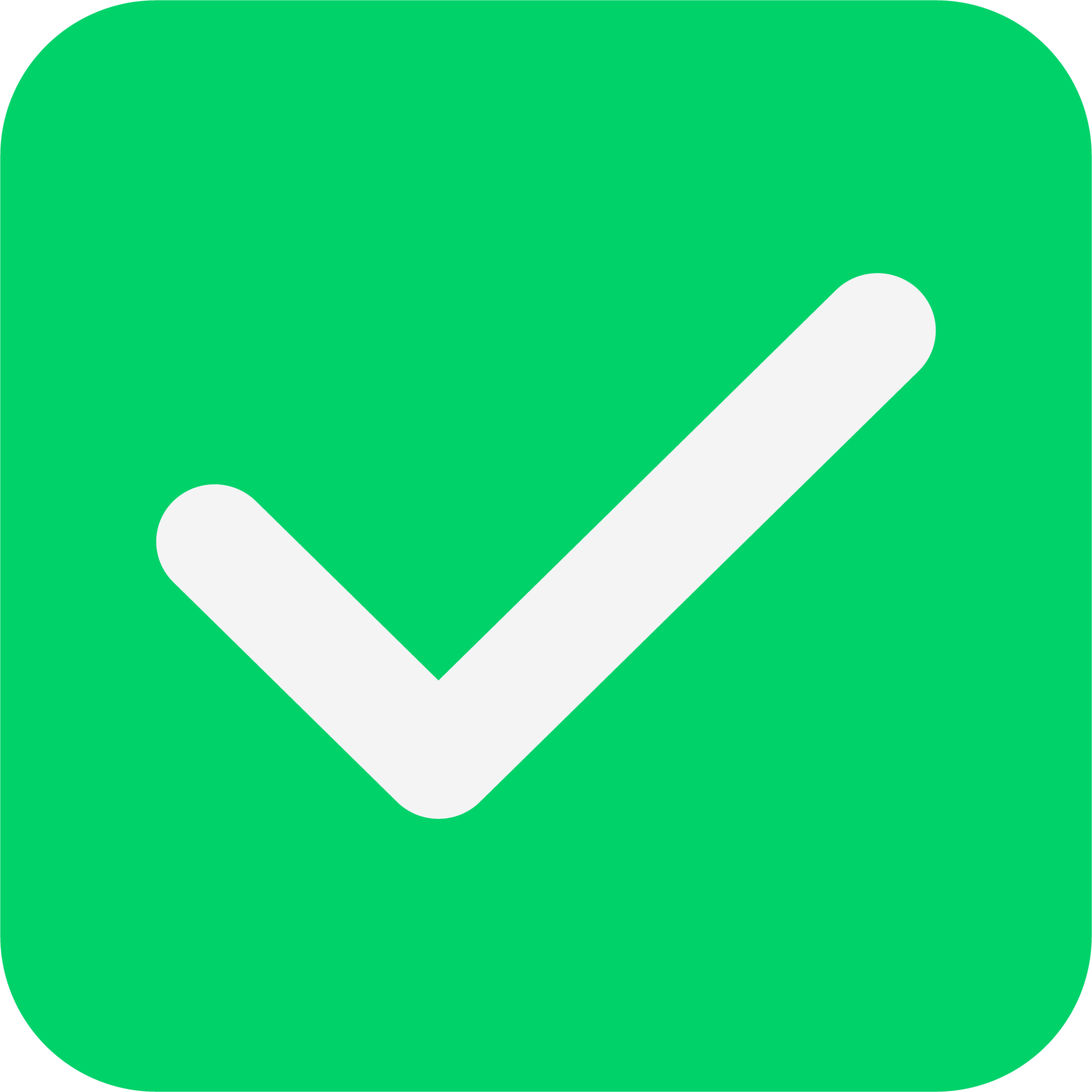
We aimed to aid public safety workers by creating a product that enhances their experience navigating and managing files. We completed this by designing an intuitive wearable app that corresponds and communicates with a physical body-worn camera while simultaneously allowing for the following main features: distinction between transferred and un-transferred files, media tagging and view of integrated metadata, appending video data to files, and viewing system and device notifications. Additional secondary features meant to establish trust and improve experience included the ability to have a live view of the BWC and chat system, note feature, customizable folders, and pinging features.
Objectives
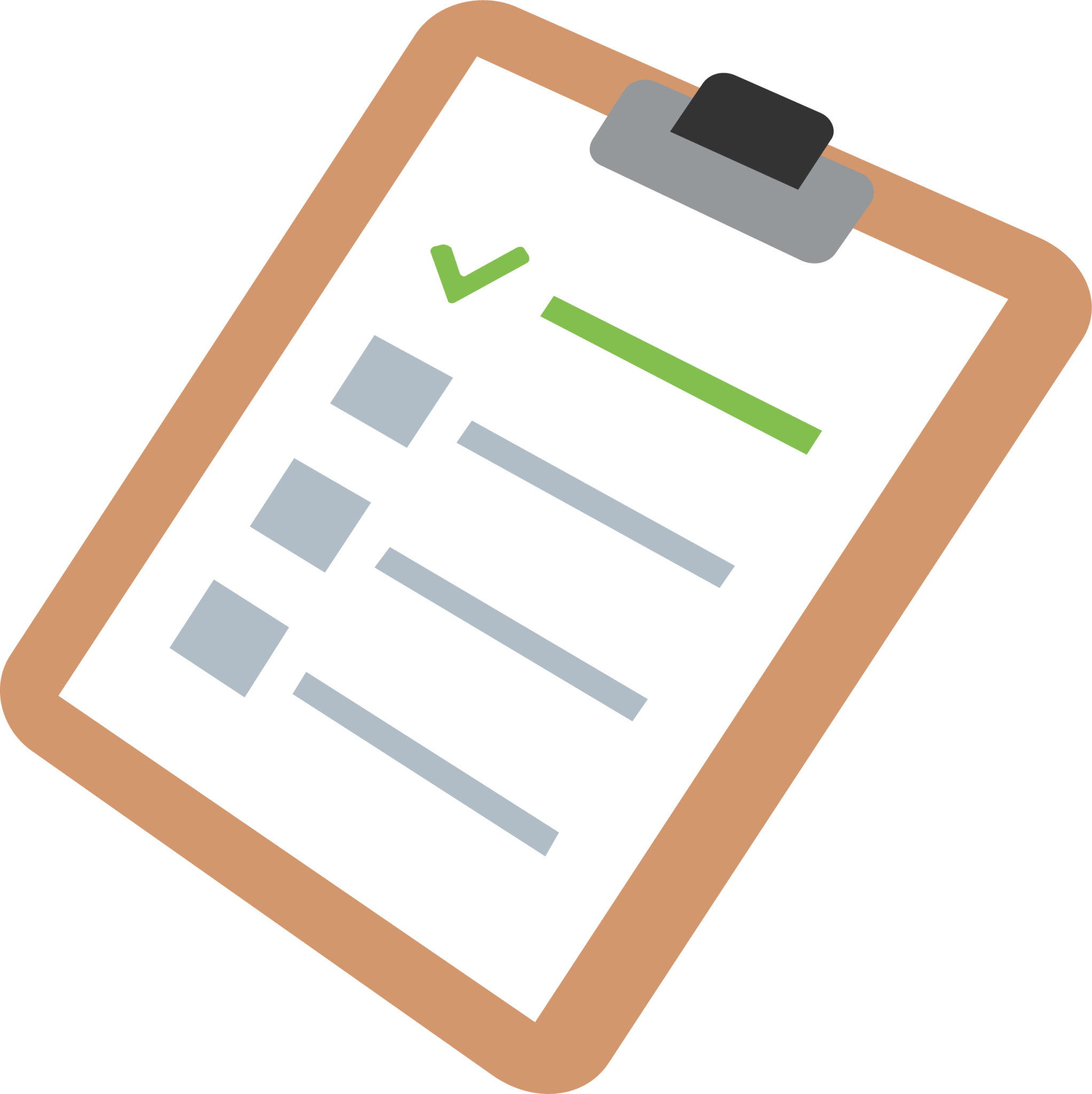
-
Design a responsive mobile app that serves as a file repository that maintains file integrity by preserving original file format and metadata.
-
Distinguish between relevant files by having each recorded incident with its own file or relevant files with a unique file name or code.
-
Allow users to append accompanying video data (photos, text and audio notes.)
-
Display system notifications and device indicators that come directly from the BWC.
-
Design further additional features meant to enhance overall user experience (i.e. live camera view and chat feature.)
-
Establish trust and reliability by requiring verified accounts in order to access files.
Research
Research Context
It was then time to conduct my research on BWC use cases, current trends, opportunities, and design characteristics. From my research, I identified the following pain points and opportunities:
-
There is a lack of camera activation that leads to uncaptured critical moments.
-
Privacy concerns and unverified alteration to original files are on the rise.
-
Storage capabilities and a lack of accessibility are a growing concern amongst investors and public safety workers.
Research Opportunities
After my secondary research, I went on to look at various examples of established public safety companion apps in order to best understand UI areas for improvement and consideration to apply in my app. From my research, I identified the following standards and opportunities:
-
File Repository Design
-
Accent colors highlight key elements, while core brand colors remain minimal.
-
Tags, details, and notifications use prominent colors for better visibility.
-
-
File Metadata & Organization
-
Each file includes essential metadata: file size, automated description, assigned tags, and a unique identifier.
-
Video files feature quick thumbnails for easy recognition.
-
Custom tags are categorized by type (e.g., “Drug Possession,” “Car Accident,” “911 Call”) for better organization.
-
-
File View Structure
-
Research identified an optimal top-to-bottom layout:
-
Video preview with playback
-
Tag details
-
Description
-
Notes
-
File size
-
Creation date
-
-
-
Real-Time System & Device Notifications
-
Critical updates include:
-
Battery life
-
Storage status
-
Live coordinates of the BWC’s location
-
Essential alerts with clear iconography
-
-
Target Users
With these pain points identified, and background solidified, we narrowed down the target audience to the following:
-
Police First Responder/Frontline
-
Highway Patrol
-
Corrections Officers
-
Certified Medical Aides (CMA)
-
Licensed Vocational Nurses (LVN)
-
Administrators
Further research revealed the following key user considerations we needed to keep in mind as we transitioned into designing:
-
The system design language should be the same for the physical BWC and the mobile app, as they must communicate constantly and consistently.
-
The distinction between file types (e.g., transferred and un-transferred) must be available at a glance. In addition, files need to be tagged according to their material.
-
The general design must be the same for nursing employees and administrators to facilitate faster form completion and case reviews.
Design Process
Team Brainwriting Session
To begin getting a holistic view of my overall design process, I began by creating a flowchart outlining my intentions:
Although not exhaustive nor mandatory, this flow chart would allow me pace myself and effectively contribute to every major step of the development process with my teammates help.


Concept Map
In order to begin understanding how to organize our system, we began with a concept map that broke down our main, essential components:

User Task Identification
With a solid foundation of the core functionality we want to add, my team further honed into the exact user tasks the user can accomplish. Our final tasks are as follows:
-
Primary Tasks (core functionality):
-
Search for video capture.
-
Preview video and access data.
-
Append accompanying video data (Photos, files, typed text, stt, and notes).
-
View/dismiss system notifications.
-
View device indicators
-
-
Secondary Tasks (supporting functionality):
-
Access live view of the body worn camera.
-
Access live chat feature with surrounding officers.
-
Create customizable folders for videos.
-
Share notes with other officers.
-
Allow supervisors to ping officers when situations escalate and interaction becomes unprofessional.
-
Sketches





LowFi Wireframes
In my low fidelity iterations, I began experimenting with icon, text, and data placement for both mobile and tablet views. I mainly focused on the best ways to chunk relevant information while simultaneously providing a simple interface for nurses on the go.
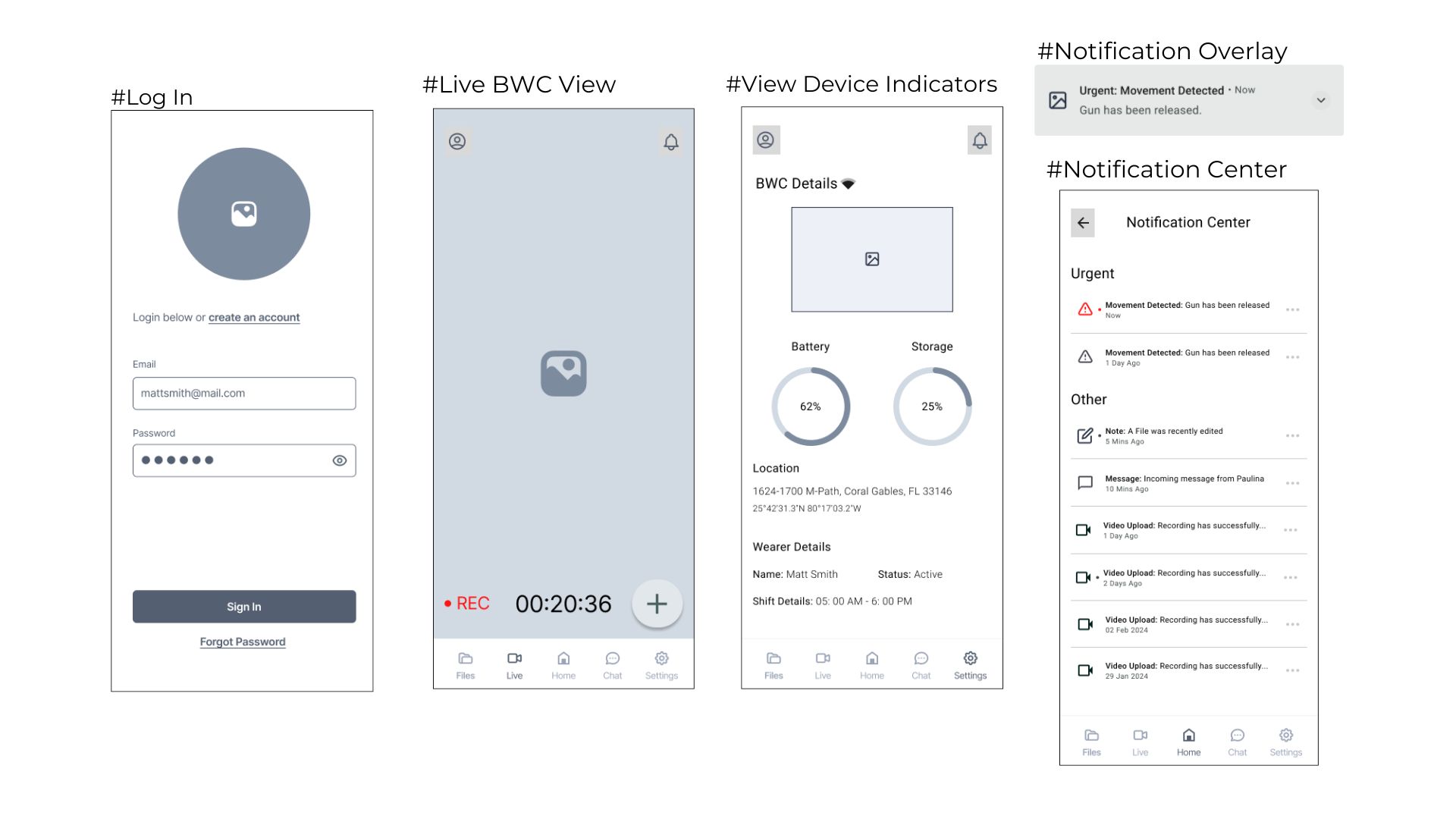


Style Guide

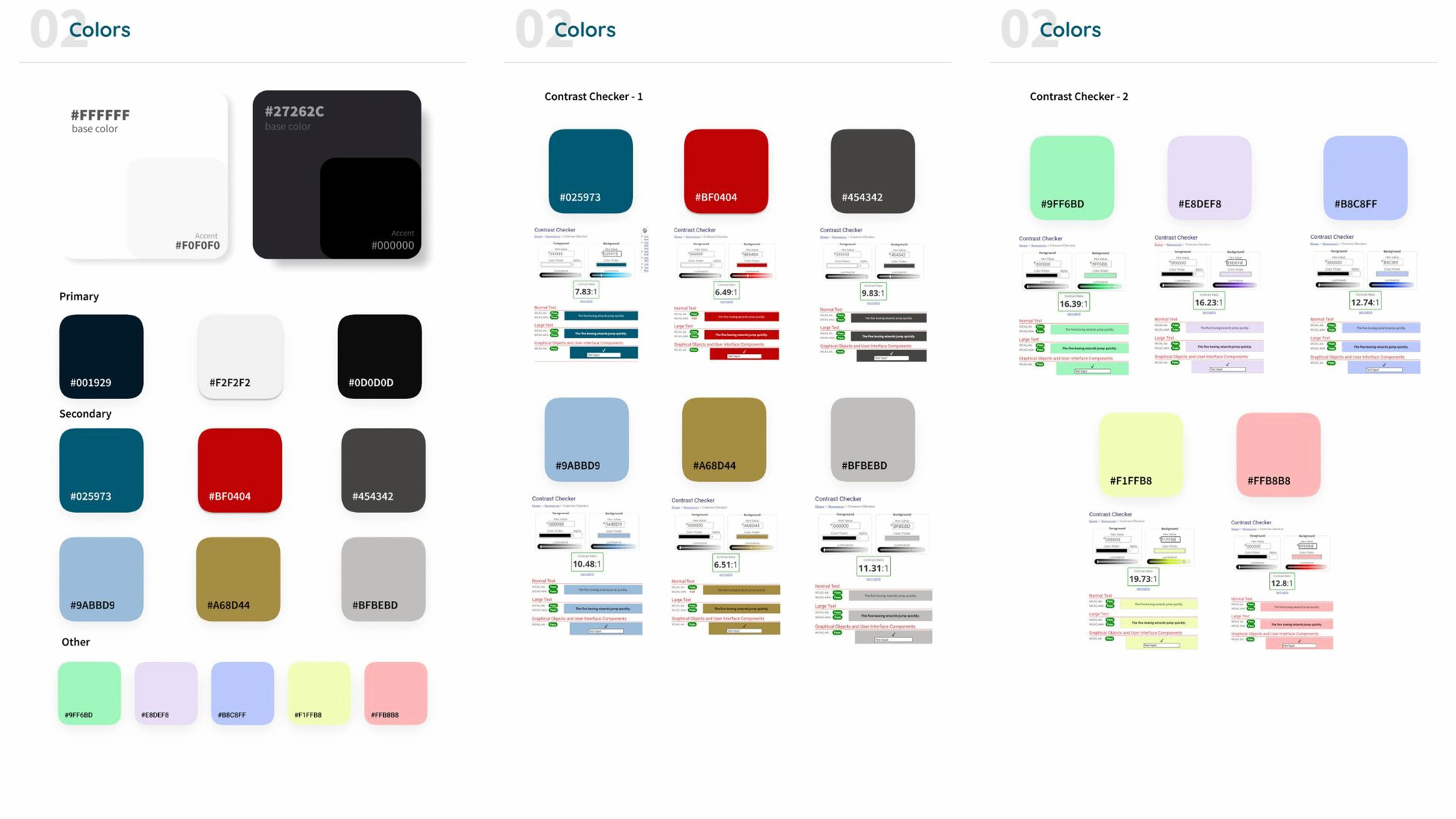

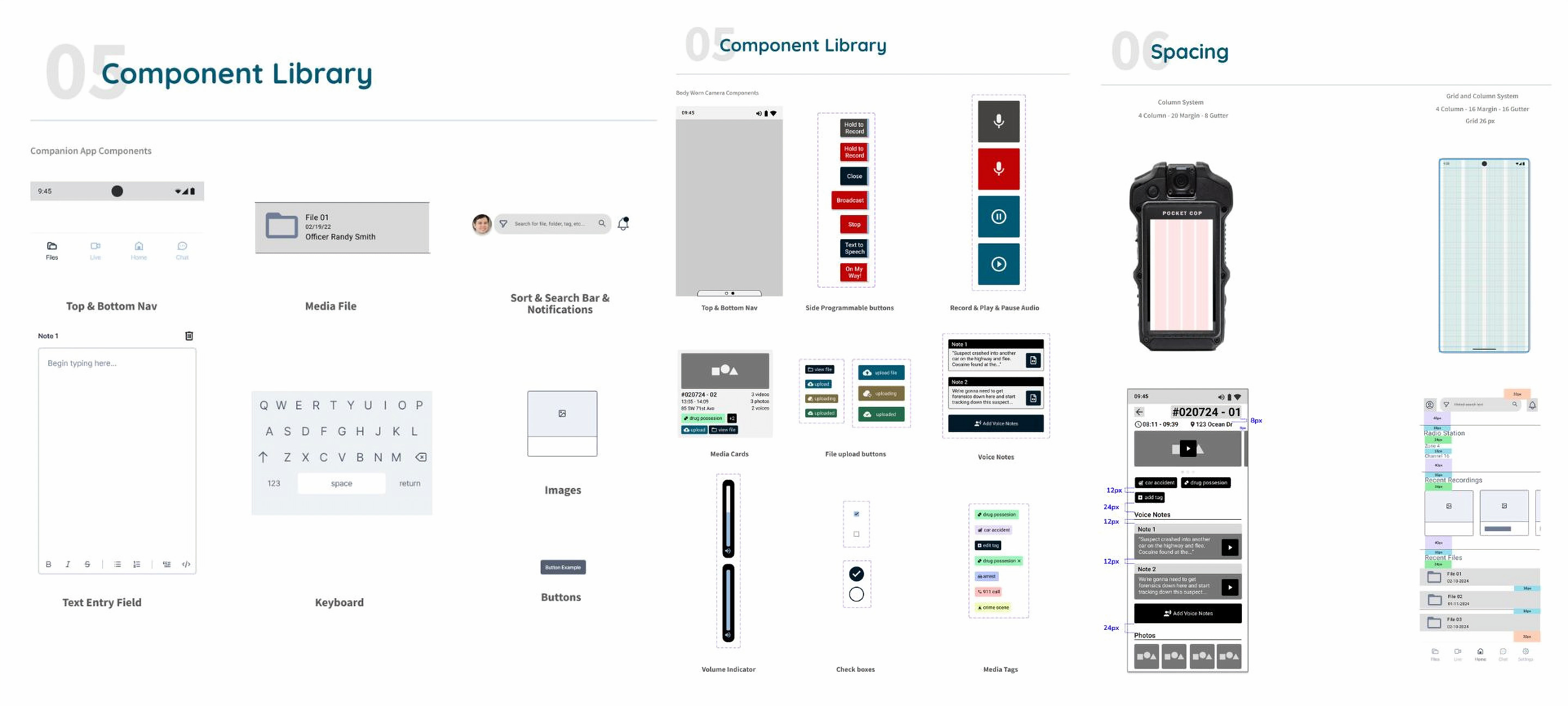

HiFi Wireframes








Usability Testing
We conducted three testing sessions using the first version of our prototyping with the feedback capture grid method, with one moderator, one observer, and one tester. Afterward, we compiled and evaluated our findings.
Our product is an app meant to serve as a repository for the body-worn camera’s files. Our objectives for this evaluation were to pinpoint areas of improvement and understand how we can improve our application by viewing what other teams have designed. Our specific evaluation tasks and goals were to understand the following:
Primary Task Objectives:
-
Identify how easy it was for users to search for and access a given file either by using a tag or by looking through a folder.
-
Observe and note concerns regarding prototyping limitations and the user’s first major touch points.
-
Note how easy it was for users to append data.
-
Discover new opportunities to enhance system and device notifications for easier understanding.
Secondary Tasks Objectives:
-
Determine what can be added to the live view of the BWC (e.g. ability to append data directly from here?)
-
Identify how easy and feasible it would be to chat with other officers and public safety workers while sharing sensitive information.
-
Note any concerns regarding privacy and areas for improvement.
Results
During my moderation sessions, the tester frequently wanted to be able to return to the previous page, but this was not fully prototyped. The tester also noted that the app’s overall color scheme, spacing, and element placement were nice. When asked to elaborate, they noted that the interface is not overwhelming and noted that they felt as if only the most relevant information was being presented at a single time. As for the team discussion sessions, we identified areas where we could improve based on our moderation/testing session. One example is the addition of a flow where the user connects the bodyworn camera to the companion app, either through Bluetooth or other means. Overall, we found we needed to clarify specific points in our prototypes and rearrange the structure of certain elements.
Next Steps
Across the app, users noted that we need to develop more ways to log into the companion app and a process to connect to the body-worn camera. Some specific notes for certain tasks are noted below:
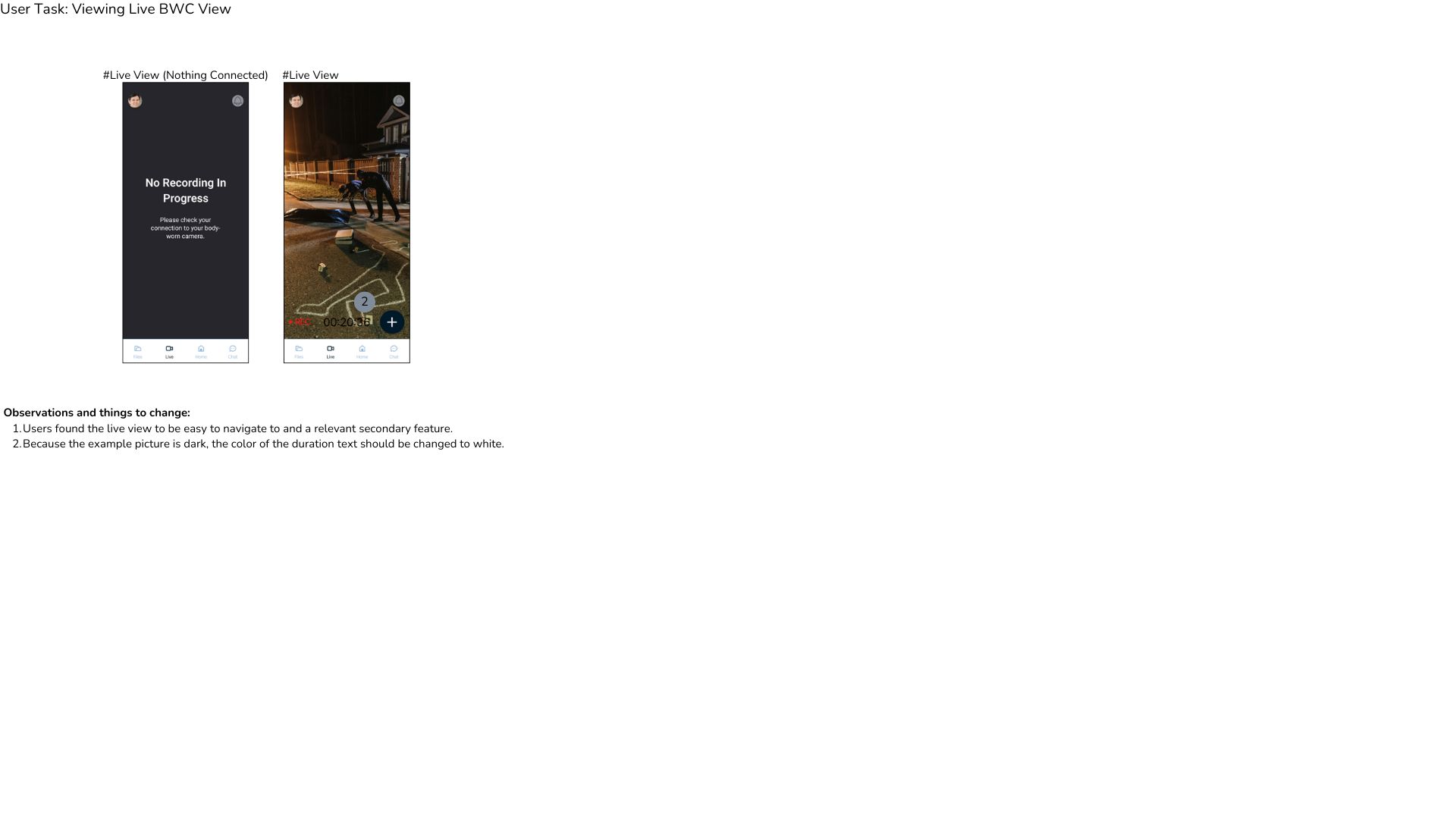


Curious to try out the prototype for yourself? Try it now!
Take Aways...
Key Learnings
Working on this project not only allowed me to reinforce my user-centered and design skills, but it also prepared me to understand the constraints involved in designing a file repository. It was the first time I designed something like this, but I thoroughly enjoyed the realistic scenarios and constant focus on designing for public safety workers, whom frequently need to maintain authenticity with their records in a way that does not take away time from their critical responsibilities. I also noted many opportunities for improvement within the empathy research and usability testing stages. It was my first time using the feedback capture grid method to identify usability frustrations, and as such, there was much that I could have noted and documented at that moment.
Future Iterations
Going forward, I’d like to revisit the research and usability testing stages. If possible, I’d like to get direct input from public safety workers themselves on their frustrations with the current body-worn camera companion apps to further empathize with their needs. In addition, my testing documentation could be revisited to portray results and opportunities in a new light.